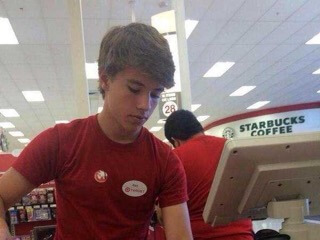If you’re friends with any teenaged girls on social media, you may have heard about #AlexFromTarget.
Of course, so many people got to talking about the latest viral social media meme featuring Alex Laboeuf, a Target employee from Frisco, Texas, with a perfect jawline and a dreamy side swept mop, you may have heard about #AlexFromTarget even if you don’t keep up with what teenaged girls are talking about.
Here’s what we know: On Sunday, Nov. 2, a Twitter user named @auscalum tweeted a photo of a cute young man, minding his own business, just working at Target.
His name tag identified him as Alex.
According to Topsy, by that same evening, plenty of people on Twitter were talking about “Alex from Target.”
They weren’t all swooning teenagers … but plenty were. And, as #AlexFromTarget picked up steam, it turned into a full-on meme with plenty of funny variations and jokes.
A fake Christmas ad featuring Alex, an Alex pledge of Allegiance, and even Alex spin-offs, such as Kieran from T-Mobile.
But Alex was the star. He was tweeted about more than a million times in a matter of days.
(Naturally, a good many people also were talking about Alex to complain about someone becoming Internet famous just for being attractive. Can you imagine?! The humanity!)
Adweek speculated on whether Target should put Alex in actual ad campaigns (the consensus seemed to be: “If Alex can handle it”).
The story was picked up widely.
Target responded (their Alex tweet received, last we checked, more than 29,000 retweets and 45,000 favorites).
And we might have let it go at that, but it turns out, as has so often been the case lately, reports surfaced that this “organic,” “viral” social media fad may have had some engineering behind it.
Claiming Credit for Viral Social Media?
On Nov. 4, CNET reported on a company called Breakr that strives to connect “fans with their fandom,” and is still in beta.
Breakr CEO Dil-Domine Jacobe Leonares wrote a LinkedIn post about the campaign, titled “#AlexFromTarget: The Power of Fangirls.”
The post says the company had fun with the hashtag after “one of our fangirls from Kensington, UK” posted the picture of Alex on Twitter.
After spreading the word amongst our fangirl followers to trend #AlexFromTarget, we started adding fuel to the fire by tweeting about it to our bigger YouTube influencers.
The claim was that Target wasn’t involved; it was just an experiment.
But the story gets muddier from here. The fangirl from the UK who has largely been credited with first sharing the photo on Twitter claims she does not work with Breakr and doesn’t know anything about the company.
Buzzfeed did a follow up story with an interview from Leonares, and the Breakr founder made more refuted claims about collaboration with people originally involved in the meme.
Even more speculative news stories followed.
So What the Heck Happened?
Unfortunately, I can’t give you answers to that.
Did Breakr pile on when they saw an interesting viral social media trend gaining traction?
Perhaps.
Did they try to take undue credit for the viral sensation in order to generate attention, and, perhaps, investors?
I wouldn’t be surprised if that’s the case.
But chances are, Leonares will pay for that attempt.
Many girls who participated in the phenomenon (not sure whether they’re “fangirls”) are already taking to Twitter to bash the company for trying to take credit for the meme.
As muddy as the story is, a few things seem clear to me:
- We still have a hard time tracking viral social media messages and really understanding where they came from and how they spread. It’s no surprise, then, that it’s so difficult to explain to clients that one doesn’t just “go viral.”
- Newsjacking is one thing, but trying to take credit for a viral social media trend you didn’t create is a terrible idea (click to tweet).
Target and Alex are the winners here. They’re both going to be just fine.
